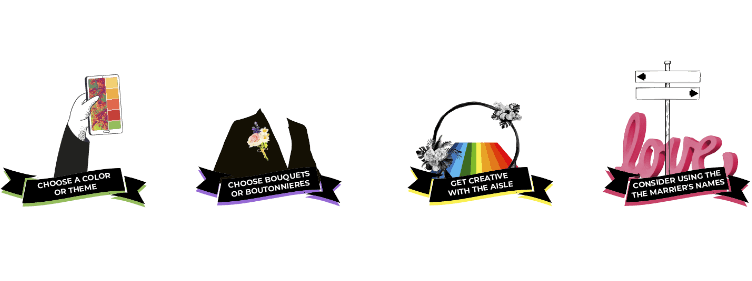
Weddings are full of traditions and rules that are gender-specific. With the accessibility to same-sex marriage in many countries on the rise, it is time to introduce a new vernacular for the big event that is inclusive of everyone present. It is time to do away with gendered terminology and evolve our language to include gender-neutral wedding terms.
This is a beautiful practice for society to grow more inclusive and less inhibited by traditional rules. As gender identities continue to bloom, everyone feels safe, respected, loved, and included at one of the biggest moments of a couple’s life together.
Gender is a social construct. It is a set of societal and cultural beliefs and norms associated with a person’s assigned sex at birth. For example, if you were born with testes, you were assigned the sex of a male, society would expect you to conform to the gender role and assume you will present this way.
Society, in general, is becoming increasingly aware that biological identifiers (assigned sex) and gender identifiers are two separate things. Some people see no reason to present themselves in alignment with their given sex and prefer to break social norms with a personalized identity and presentation.
Gender is highly diverse. Using gender-neutral pronouns at your wedding will ensure all your guests feel included and cherished.
The beauty of gender inclusivity is that it aims to involve everyone. No one needs to be left out of the wedding based on how they present and identify themselves. It is very common to have a myriad of gender representations on all sides of the wedding party.
A wedding is about bringing together those you love and cherish to celebrate the commitment and union of your partnership. Everyone you love and cherish should be present regardless of how they identify.

It can be tricky unlearning and relearning how to address people in specific wedding day roles. While the following terms can be useful, it is important to ask people their preferences. Perhaps they want the traditional title of Maid of Honor or Best Man? Inviting inclusivity into the wedding day means extra care in communication.
Gender-inclusive role replacements include:
| Gender Inclusive Term | Traditional Term |
|
|
|
|
|
|
|
|
|
|
|
|
When discussing your ceremony with your officiant, let them know your preferred pronouns and any changes you’d like to make to the language used during the ceremony. This list provides a deeper dive into dropping gendered speech and a lengthier list that reframes wedding-specific roles.
There is already a healthy supply of gender-neutral terms for wedding chatter. A non-exhaustive list includes fiancée, partner, significant other, spouse, and newlywed.
By continuing the use of these terms by people in the LBGTQIA+ community and cis-gendered humans, we can help protect those who aren’t ready to reveal their identities. If you are unsure how another identifies, these are safe terms to return to. They also provide easy-to-use language that is inclusive regardless of how a couple identifies.
Communication and words are powerful tools. They are what binds the two of you in marriage. If you’re comfortable discussing the topic, try asking those in the wedding party how they prefer to be addressed. This is an excellent opportunity to deepen your relationship and learn more about gender inclusivity.
If you’re not comfortable starting this conversation yet (and there is no shame in this, it is a touchy subject that deserves deep attention), aim to use gender-neutral terms.
Loosen your grip on tradition and lean into providing a safe space. Recall that what truly matters is not how someone identifies but how they show up in the world. If you want your brother to be your Maid of Honor, then do it. If your partner has four sisters and wants them as his groomsmen, make space for it. There are no hard and fast rules here. This is your special day, and it should go exactly the way you want it to.

Traditionally the bridal party is all women, and the groomsmen are all men, but mixed gendered wedding parties are becoming more common, and you should have exactly the people you want standing next to you as you say, “I do.” Much of this comes down to changing vocabulary to create an inclusive atmosphere, but here are a few tips for incorporating mixed gendered wedding parties into traditional ceremonies:

Other important gender-inclusive swaps and ideas:
Get in the habit of using gender-inclusive language as it can be applied in any situation regardless of whether or not you know someone’s gender identity. There is immense fun to be had without assigning a gendered title to the event or those attending. The future of inclusive wedding language is about finding the language that is fully inclusive and also fits with you.